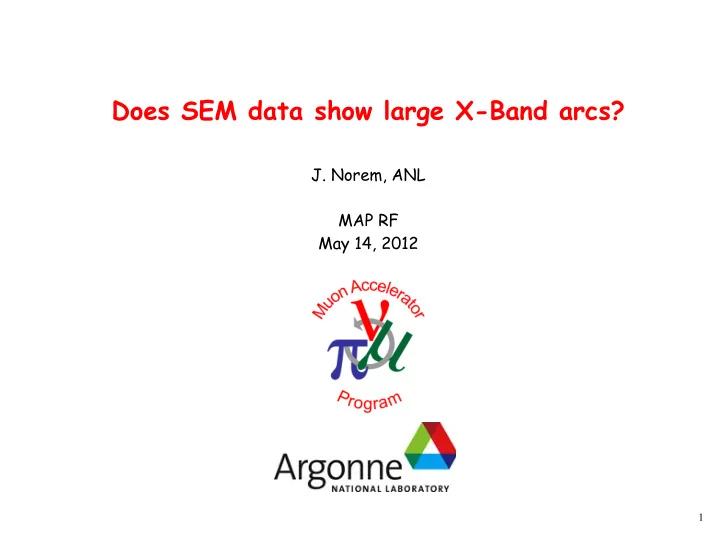

Does SEM data show large X-Band arcs? J. Norem, ANL MAP RF May 14, 2012 1
���� ���� ��� ��� ��� ��� ���� ���� � �� ��� � � � � � � � ��� ��� ������� ���������� ��� � � � � ��� ���� �� � ������ � � �� �� �������� � � �� ��� �� ���� ��� �������� �� ���� ����� ��� �������� ������� ��� ���������� ��� � ������� �������� ����� ��� ��� ������� �������� �� ����� ������ ��� ����� ��� ������� ����� ���� ���� ������ �������� ����� ����� �� ������ ������� ������� ������ ���� �������� ���� �� ������ ��� ������ �� � �� � � � �� � ������� �� An instability driven by field emission seems to limit E surf . Rising densities produce fields that produce FE currents that short the sheath and decrease the surface density and field. (“Ecton” “quantization” ?) � � � � � � � � � � � � � 2
� ��� ������� �������� ����� ������� ���������� � � � � � ��� � � � �� ���� ���� ���� ��� ��� ��� ��� ������� �������� �� ����� ��� ������ �� � �� � � � �� ������� �� �� ���� ��� �������� �� ���� ���� ��� ��� ��� ��� The specific mechanism is: � � � � � � � � � � � � � 3
805 MHz shorting currents Is there a maximum field emission current density allowed by dense plasmas.? This current density should be: ~ 20 MA/m 2 uniform over large areas, ( ➜ uniform plasma) Our pillbox cavity requires ~ 4 A to short in ~ 100 ns. Our arcs have a melted area of around 0.25x10 -6 m. This would give a shorting current of (20 MA/m 2 )(0.25x10 -6 m 2 ) ~ 4 A. 4
At X-Band Dolgashev, CERN 2009 5
X-Band shorting currents Absorbing the traveling wave rf power in these small structures requires ~ 1000 A. The model, and the current density limit, should still be valid. The arc area should be around (1000 A)/( 20 MA/m 2 ) ~ 5x10 -5 m 2 . ~ 0.5 cm 2 . Do huge arcs exist? 6
SEM images There are a lot of them. Gonzalo Arnau Izquierdo CERN workshops 2006, 2007, 2008, 2009, 2010 Marcus Aicheler CERN workshop 2010, Helsinki mtg 2011 Lisa Laurent IVEC 2009 There is lots of evidence for large. uniformly melted areas. SEM images are selected at all stages for artistic value, and not randomly sampled. 7
Many SEM images look like this but not all of them, 8
G. Arnau Izquierdo 9
G. Arnau Izquierdo 10
G. Arnau Izquierdo classic spinodal decomposition 11
L. Laurent, IVEC 2009 12
M. Aicheler 2011 13
M. Aicheler 14
Craters and splashes look similar. V. Dolgashev D. Miller 15
Summary Oscillations at ~ 100 MHz are commonly seen in arcing. We can explain them by E max and current density limits. The surface parameters produce shorting current values at 805 MHz. X-Band data doesn’t fit unless the arcs are very large. SEM data may show this. 16
Recommend
More recommend